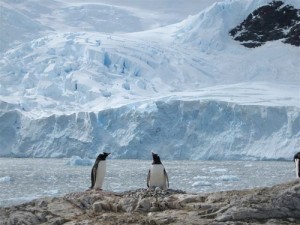A UK-led group of climate researchers claim their research has demonstrated for the first time that human activity is responsible for significant warming in both polar regions.

Rising Arctic temperatures and the accelerating retreat of sea ice in the Arctic Ocean has been widely reported in scientific journals and the popular press. However, these changes have not formally been attributed to human influence because of sparse observations and natural variability.
Temperature trends are much less clear over the Antarctic, the only continent where anthropogenic changes have not been detected, according to the 2007 report of the Intergovernmental Panel on Climate Change.
However the paper Attribution of Polar Warming to Human Influence, published in Nature GeoScience this week, suggests that the observed changes in both regions are not consistent with natural climate variability and instead ‘are directly attributable to human influence’.
They go on to say that their results show human activities to have caused significant global warming in both regions, along with “likely impacts on polar biology, indigenous communities, ice-sheet mass balance and global sea level.”
Professor Peter Barrett of the Antarctic Research Centre and Climate Change Research Institute at Victoria University of Wellington comments:
“The group reported the results as changes in land temperature for each region averaged every 5 years, plotting temperatures simulated using 4 CIMP3 climate models with natural forcings, or causes, alone against both natural (solar irradiance changes and volcanic aerosols) and anthropogenic forcings (greenhouse gases, sulphate aerosols, stratospheric ozone depletion).
“The plots show little difference until 1975-79 in the Arctic and 1980-84 in the Antarctic after which the trends diverge. Temperature modelled to 1995-99 continues unchanging with natural forcings but with combined natural and anthropogenic forcings it rises steadily by 1.0ºC in the Arctic but only 0.3ºC in the Antarctic.
“Interestingly, observed temperatures plotted in the same way were not plainly rising until 1995-99 in the Arctic (by 1.5ºC) and in 2000-04 in the Antarctic (by just 0.2ºC), a delay that may point to an element in this part of the climate system not yet incorporated into the models.
“The observed temperature trend for the Arctic also shows a ~60 year trough-to-trough cycle (2ºC trough-to-peak range) not seen in the computer simulations, likely a consequence of natural oceanic heat storage and release. The Antarctic record also shows a natural anomaly not reflected in the simulations – the 1950-54 temperature low (-1.5ºC) recorded at Faraday Station on the Weddell Sea coast.
“While these similarities and differences are evident from inspection of the data, establishing cause and effect is more difficult. The group has used a detection and attribution analysis procedure first used to detect anthropogenic influence on global temperature and more recently on both physical and biological impacts on a continental scale. The authors noted that in both the Arctic and the Antarctic “the anthropogenic coefficient is significantly greater than zero, indicating a detectable response to anthropogenic forcing”.
“This conclusion is unsurprising for the Arctic, where both the magnitude and the consequences of rising temperatures have become increasingly evident over the last two decades. However, it is surprising for the Antarctic, on account of the sparseness of the data – from less than two dozen locations for an area of 13 million square km and those mostly around the margin, the modest temperature changes observed, apart from the substantial rise in the tail of the Antarctic Peninsula, and the shortness of the time series.
“But how long should the world wait before responding in a substantive way? According to a report earlier this year Antarctica in 2006 was losing ~ 200 gigatonnes of ice a year. This has a relatively small effect on rising sea level, contributing just 0.4 mm compared with the current rate of 3.4 mm/year. However, the overall rate increased by 70% in the previous 10 years. With carbon emissions continuing to rise, the results of this study suggest ice loss could accelerate further.
“The results are of equal or greater concern for the Arctic region. Continued warming, with loss of sea ice and permafrost, will continue the changes to biota and culture identified in the Arctic Climate Impact Assessment of 2005. It will also create further risk from the release of large volumes of methane trapped beneath the Arctic Ocean and the surrounding tundra. This gives both weight and urgency for an international agreement for curtailing greenhouse gas emissions that would eventually reduce atmospheric CO2 concentrations back to 350 ppm.”
Professor Martin Manning, Director, Climate Change Research Institute, School of Government, VictoriaUniversity of Wellington comments:
“Several of the authors of this paper were lead authors for the IPCC Working Group I report and the results they use come from some of the best climate models available.
“However, attributing warming to a human influence involves a degree of expert judgment and a single study such as this should not be seen as equivalent to the attribution statements in the IPCC reports that involve a wider range of experts and a more extensive peer review process.”
Contacts:
Peter Barret 027 563 5336, Peter.Barrett@vuw.ac.nz
Martin Manning 04 463 5474, Martin.Manning@vuw.ac.nz
Report author A.Karpechko@uea.ac.uk
+44 (0)1603 59 2721
For more information, please contact the Science Media Centre on tel: 04 499 5476 or email: smc@sciencemediacentre.co.nz.
Notes to Editors
The Science Media Centre (SMC) is an independent source of expert comment and information for journalists covering science and technology in New Zealand. Our aim is to promote accurate, bias-free reporting on science and technology by helping the media work more closely with the scientific community. The SMC was established by the Royal Society of New Zealand with funding from the Ministry of Research, Science and Technology. The views expressed in this Science Alert are those of the individuals and organisations indicated and do not reflect the views of the SMC or its employees. For further information about the centre, or to offer feedback, please email us at smc@sciencemediacentre.co.nz.